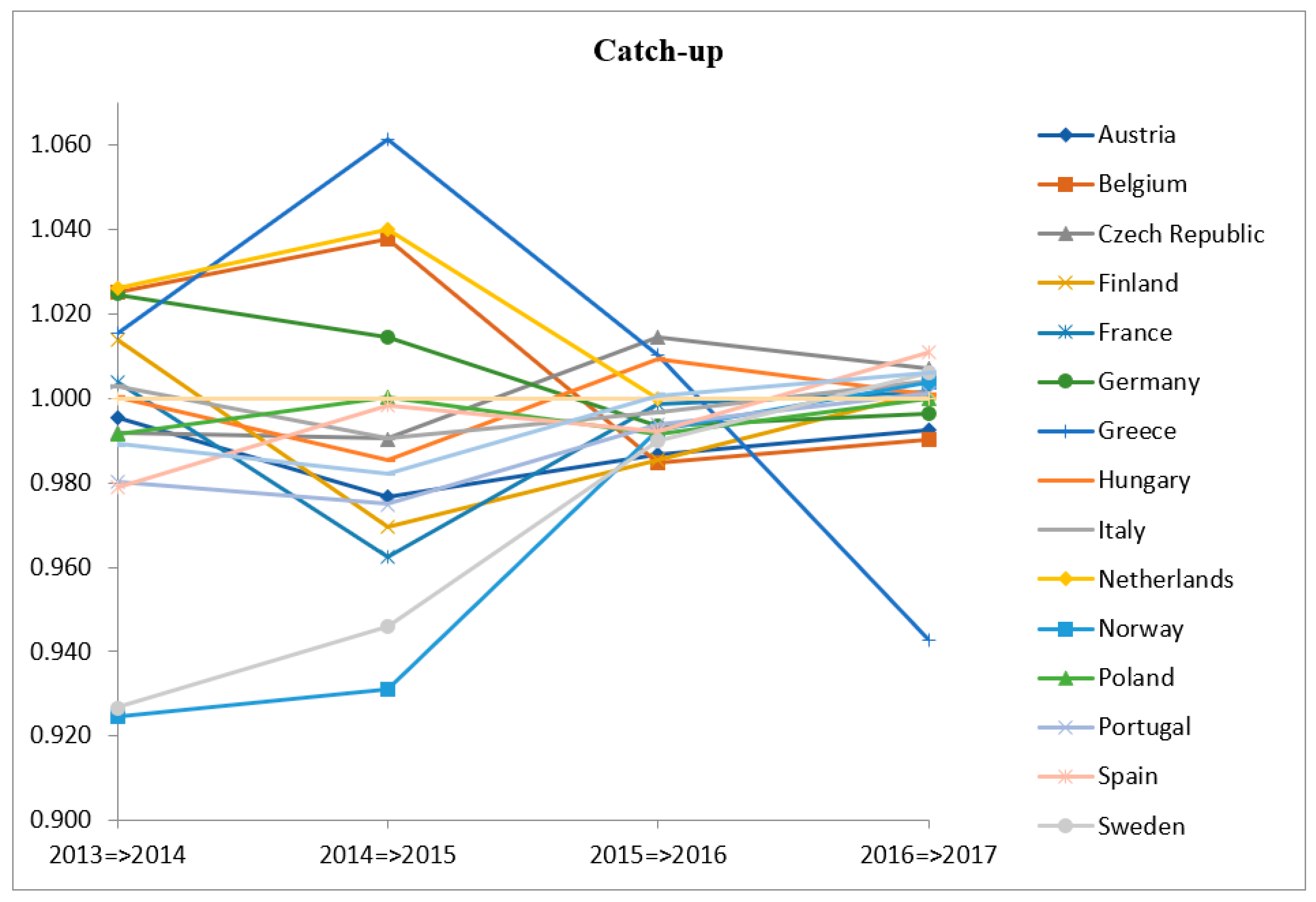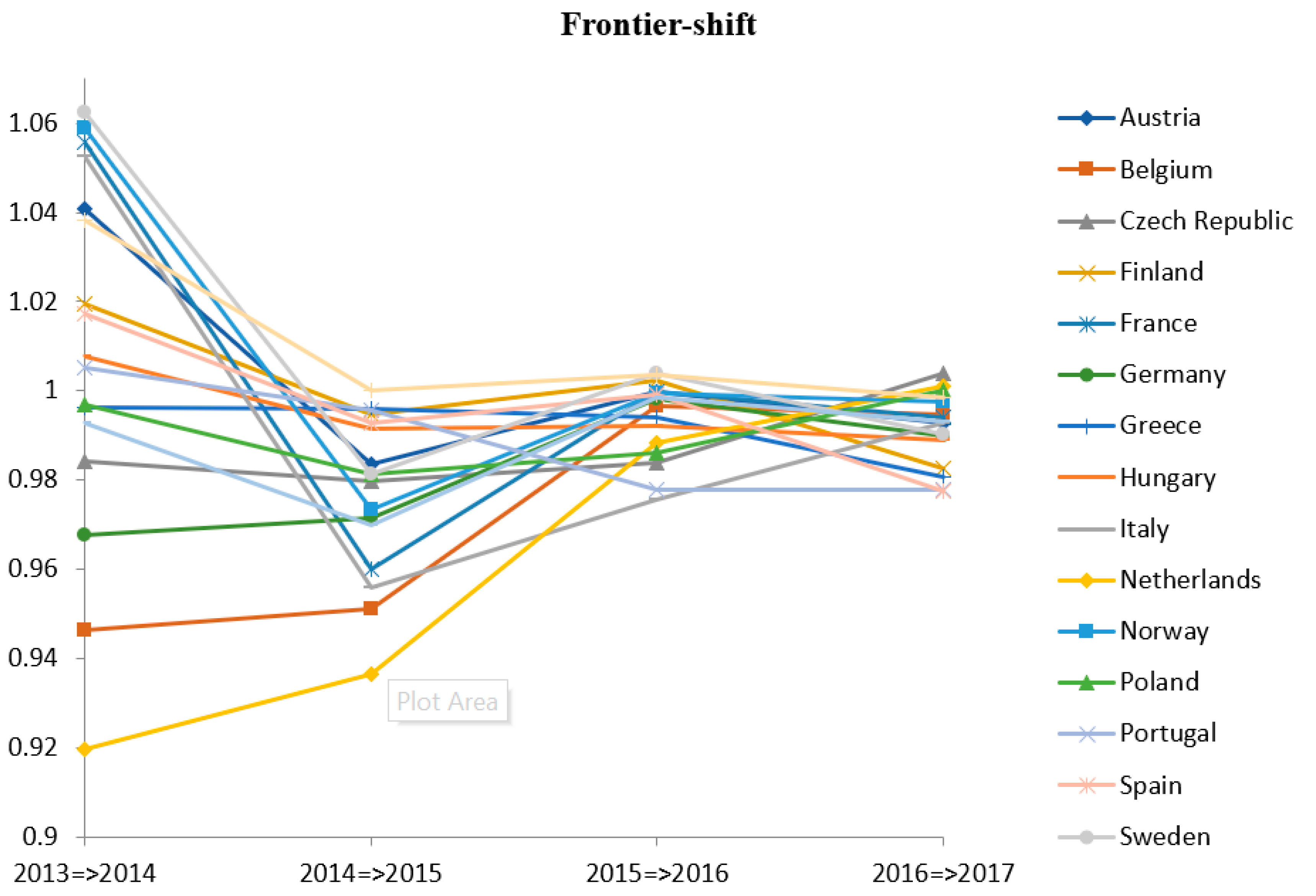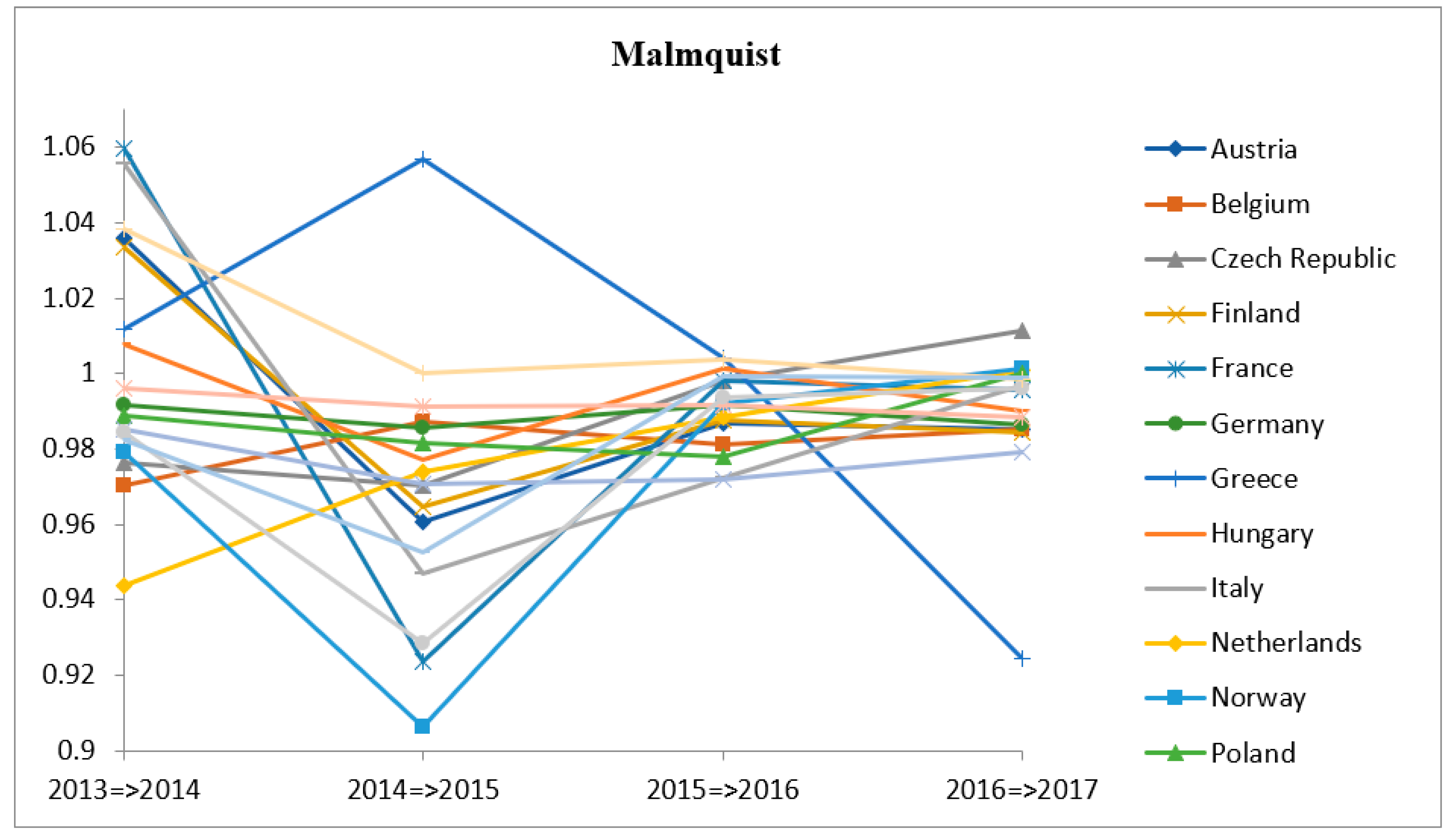5.2. Changes Analysis for DMUs Using MPI
This section shows the change analysis for these DMUs in each year from 2013 to 2017.
Section 5.2.1 shows the efficiency change,
Section 5.2.2 shows the technological efficiency change, and
Section 5.2.3 shows the productivity change. The DEA-Solver Pro was used to run the MPI under variable return to scale (VRS).
5.2.1. Efficiency Change
Table 7 shows the year-on-year efficiency changes (or catch-up effect) for the 17 DMUs from 2013 to 2017.
Figure 2 shows a diagram of the results.
From 2013 to 2014, seven countries were found to have improved efficiency—the Netherlands, Belgium, Finland, France, Germany, Greece, and Italy (with a greater-than-1 efficiency change score). This implies that these seven countries improved the use of inputs to produce more desired output (GDP) and lesser undesired output (CO2). Among the seven countries, the Netherlands had the best improvement (+2.6%). However, the improvements made by these seven countries are minor. There are two countries (Hungary and Switzerland) with no change. The remaining eight countries recessed in their efficiency. They are Austria, the Czech Republic, Norway, Poland, Portugal, Spain, Sweden, and the United Kingdom, due to a less-than-1 efficiency change score. Among the eight countries, Norway recessed the most (−7.5%), followed by Sweden (−7.3%). From 2013 to 2014, the 17 countries as a whole improved 0.6%.
From 2014 to 2015, 4 countries are found to have improved efficiency. They are Greece, Belgium, Germany, and the Netherlands (with a greater-than-1 efficiency change score). Among these four countries, Greece improved the most (+6.9%). Another three countries recessed. They were Finland, France, and Italy. Two countries (Poland and Switzerland) kept no change in their efficiency. There are 11 countries with deteriorated efficiency—Austria, the Czech Republic, Finland, France, Hungary, Italy, Norway, Portugal, Spain, Sweden, and the United Kingdom (with a less-than-1 efficiency change score). However, the number of recessing countries increases to 11 from 7. Among the 11 countries, Norway once again recessed the most (−6.9%). From 2014 to 2015, the 17 countries as a whole recessed 0.8%.
From 2015 to 2016, four countries were found to have improved efficiency. They are the Czech Republic, Hungary, Greece, and the United Kingdom (with a greater-than-1 efficiency change score). Among them, the Czech Republic is the countries with the best improvement (+1.5%). Two other countries, the Netherlands and Hungary, had no change on their efficiency. The rest 11 countries had a regressive efficiency. They are Austria, Belgium, Finland, France, Germany, Italy, the Netherlands, Norway, Poland, Portugal, Spain, Sweden, and Switzerland (with a less-than-1 efficiency change score). Among the 11 countries, Belgium had the worst regression (−1.5%). However, the regressions and improvements of these countries are minor. From 2015 to 2016, the 17 countries as a whole recessed 0.3%.
From 2016 to 2017, 10 countries are found to have improved (from 4 to 10). They are Spain, Czech Republic, Finland, France, Hungary, Italy, Norway, Portugal, Sweden and United Kingdom. This implies more countries can better use inputs to produce more desired output (GDP) and less undesired output (CO2 emissions). Among the 10 countries, Spain improved the most (+1.1%). Three countries (the Netherlands, Poland and Switzerland) kept no change on their efficiency. 4 countries had recessed efficiency. They are Austria, Belgium, Germany and Greece. Among the 4 countries, Greece recessed the most (−5.7%). From 2016 to 2017, the 17 countries as a whole recessed 0.2%.
The last column in
Table 6 shows the overall average efficiency changes of DMUs during 2013–2017. These values range between 0.963 and 1.017. The overall average efficiency change of all 17 countries in this time period is 0.995, which shows a minor recession. The efficiency in the time period recessed the most (−0.8%) in the time period 2014–2015 and improved the most (−0.2%) in the time period 2016–2017.
It is also noted that in 2013–2017 Austria continuously deteriorated technological efficiency while Switzerland stayed unchanged and Netherlands had the best improvement (+1.7%). Greece suffered a higher regression in efficiency change from 2014–2017. Except for the Greece, other counties, after 2015, had a quite stable efficiency.
5.2.2. Technological Change
Table 8 shows the year-on-year technological changes or “frontier-shift effect” for 17 DMUs from 2013 to 2017.
Figure 3 shows the diagram.
From 2013 to 2014, 10 countries are found to have improved technological efficiency. They are Austria, Finland, France, Hungary, Italy, Norway, Portugal, Spain, Sweden, and Switzerland. This implies these countries have innovated and improved their technologies for production. Among these countries, Sweden improved its technology the most (+6.2%). However, seven countries were found to have a recessed technology efficiency, including Belgium, the Czech Republic, Germany, Greece, the Netherlands, Poland, and the United Kingdom, each of them with a less-than-1 technological change score. The Netherlands recessed technological efficiency the most (−8%). From 2013 to 2014, the 17 countries as a whole improved 1%.
From 2014 to 2015, the number of countries with improved technological efficiency was down to 0 from 10, a big drop. Switzerland had no change on the technological efficiency (due to a technological efficiency change score = 1). The other rest 16 countries recessed in their technological efficiency. They are Austria, Belgium, Czech Republic, Finland, France, Germany, Greece, Hungary, Italy, the Netherlands, Norway, Poland, Portugal, Spain, Sweden, the United Kingdom (with a less-than-1 technological efficiency change score). Among them, the Netherlands recessed the most (−6.3 %). In this time period, the 17 countries as a whole recessed 0.23%.
From 2015 to 2016, the number of countries with improved technological efficiency increases from 0 to 3. They are Finland, Sweden, and Switzerland (with a greater-than-1 technological change score). Switzerland continued to advance its technological efficiency; together with Sweden, Switzerland had the best technological efficiency improvement (+4%). However, the improvements made by these countries are not significant. Two countries had no change to technological efficiency in this time period. They are Austria and France. The remaining 12 countries had regressive technological efficiency. They are Belgium, the Czech Republic, Germany, Greece, Hungary, Italy, the Netherlands, Norway, Poland, Portugal, Spain, and the United Kingdom (with a less-than-1 technological efficiency change score). Among the 12 countries, Italy was the country with the worst regression (−2.4%). However, these improvements and regressions were found to be minor, as the best improvement is 0.4%, while the worst regression is 2.4%. As a whole, 17 countries recessed 0.6% in this time period.
From 2016 to 2017, three countries had improved technological efficiency—the Czech Republic, the Netherlands, and Poland (with a greater-than-1 technological efficiency change score). Switzerland failed to advance its technological efficiency in this time period. However, the improvements made by these three countries were found to be minor. Poland was the only country with no change to efficiency in this time period. The number of countries with regressive technological efficiency increase from 12 to 13. The 13 countries were Austria, Belgium, Finland, France, Germany, Greece, Hungary, Italy, Norway, Portugal, Spain, Sweden, the United Kingdom, and Switzerland (with a less-than-1 technological efficiency change score). Among the 13 countries, Portugal and Spain were the countries with the worst technological efficiency recession (−2.2%). However, these improvements and regressions were found to be minor, as the best improvement is 0.39%, while the worst regression was 2.9%. As a whole, the 17 countries recessed 0.8% in this time period.
The last column in
Table 7 lists the average technological changes of DMUs in the whole period (2013–2017). The values of range between 0.970 and 1.010. However, the overall average efficiency change score of all countries in the whole time period was 0.993, which was a minor recession (−0.7%). The technology efficiency of these countries improved the most (+1%) in the time period 2013–2014 and recessed the most (−2.3%) in the time period 2014–2015. This implies there was a lack of improving technologies for production from 2014–2015. After 2014, the technological efficiency of the 17 countries recessed stably and slightly.
5.2.3. MPI Change
Table 9 shows the year-on-year MPI changes for the 17 DMUs from 2013 to 2017.
Figure 4 shows the diagram.
From 2013 to 2014, 7 countries are found to have improved productivity. They are Austria, Finland, France, Greece, Hungary, Italy and Switzerland (with a greater-than-1 MPI change score). Among the 7 countries, France improved productivity the most (6.05%). 10 countries are found to have recessed productivity. They are Austria, Belgium, the Czech Republic, Germany, Hungary, Italy, the Netherlands, Norway, Poland, Portugal, Spain, Sweden, United Kingdom, and Switzerland (with MPI change score < 1). Among them, the Netherlands recessed the most (−5.6%). In this time period, the 17 countries as a whole recessed 0.2%.
From 2014 to 2015, 1 country is found to have improved productivity, down from 7, a big dip. It is Greece with an improvement of 5.7%. The country, Switzerland, kept no change. Another 15 countries, Austria, Belgium, Czech Republic, Finland, France, Germany, Hungary, Italy, the Netherlands, Norway, Poland, Portugal, Spain, Sweden, and United Kingdom recessed. Among them, Norway recessed the most (−9.4%). In this time period, the 17 countries as a whole recessed 3.1%.
From 2015 to 2016, 3 countries are found to have improved productivity, increased from 1. They are Greece, Hungary and Switzerland. Among the 3 countries, Greece improved productivity the most (+0.4%). The remaining 14 countries are with recessed productivity. They are Austria, Belgium, the Czech Republic, Finland, France, Germany, Italy, the Netherlands, Norway, Poland, Portugal, Spain, Sweden, and the United Kingdom. Among the 14 countries, Italy rexes the most (+2.8%). In this time period, the 17 countries as a whole recessed 0.9%.
From 2016 to 2017, 3 countries are found to have improved productivity. They are Czech Republic, Netherlands and Norway. Among them, Czech Republic improved the most (+11%). Poland kept no change. The remaining 13 countries had recessed productivity. They are Austria, Belgium, Finland, France, Germany, Greece, Hungary, Italy, Poland, Portugal, Spain, Sweden, United Kingdom, and Switzerland. Among them, Greece recessed the most (−7.5%). In this time period, the 17 countries as a whole recessed 0.1%.
In summary, the overall average MPI change score (0.988) shows a minor of 1.2% regression in total productivity for these 17 countries as a whole. The year-on-year productivity changes from 2013 to 2017 are found quite stable. From 2014 to 2015 the overall average productivity dipped and the number of improved countries decreases to 1 from 7. Nevertheless, the number of improved countries recovered back to 3 in the next time period from 2015 to 2016. Among these improved countries, Greece improved the most. After this time period, Greece had a big recession while others improved.
Table 10 presents the results of these MPIs for the 17 companies in the time period 2013–2017.
Table 9 shows that the average MPI changes for the 17 countries range from 1% to −12.1%. Among them, Greece improved its productivity the most (+1%), while Norway had the worst productivity recession (−12.1%). From 2013 to 2017, Greece was the only country with an improved productivity change. In the whole time period, the overall average MPI change for all countries was −5.2%.









